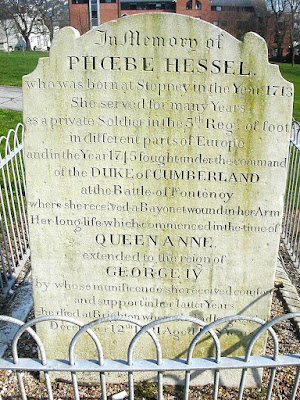Hessel was a TRUE HEROINE. She followed her lover into the army (dressed as a man) and they served together in many battles. Eventually both she and her lover were wounded at The Battle of Fontenoy in 1745. Later, when her wounds were being dressed by the Colonel's wife, her secret was revealed.
After her Service Career, she became a fish-seller in Brighton, and was a well-loved local character. Even The Prince Regent (later King George IV) appreciated her and her exploits, and he granted her a generous pension.
Hessel died in 1821 aged 108, and I walk past her grave twice daily.
If you have a moment it's worth looking at her Wiki page, to see her full exploits. An amazing woman!










What a life she had and to live to 108 in those days was rare. I’m sure there were a few Phoebes in those days. Very brave. XXXX
ReplyDeleteShe was a remarkable woman. When I see visitors looking at other gravestones I always direct them to PH's stone.
DeleteWhat a brave woman indeed. As Jackie says, she was fortunate to have reached such an age in those days.
ReplyDeleteEspecially after her exploits!
DeleteAmazing woman. It seems to me that in some cases, people like her, and Chelsea pensioners and so on, who have done heroic things during the war, live to a grand age, it must be something in their constitution.
ReplyDeleteThey probably don't have time for drink, drugs, and motorbikes.
DeleteWhen you were young, did you meet her yourself?
ReplyDeleteNo, but she did meet me!
DeleteWhat an incredible woman and to live to such an incredible age. Her exploits were so rare for a female in those days, and not too common even now - in the days of female emancipation and "enlightenment".
ReplyDeleteShe really was remarkable. She should be better known. A 'Hessel Prize' maybe!
DeleteFascinating and 108 is amazing. Regards Sue H
ReplyDeleteA grand old age. I cannot even imagine living that long!
DeleteNice to see a memorial stone with an outline of her life. It certainly is a point of interest for visitors
ReplyDeleteI do point-out the stone to visitors occasionally. They always love it.
DeleteSo much history at your doorstep.
ReplyDeleteThere is evidence of Brighton going back to the Bronze Age, but mostly our history goes back to the late 1700's when the town became very fashionable as a result of the Pavilion being built by The Prince Regent.
DeleteNow there's a woman that lived her life her way.
ReplyDeleteBravo!
Wasn't she wonderful. Some dame!
Delete